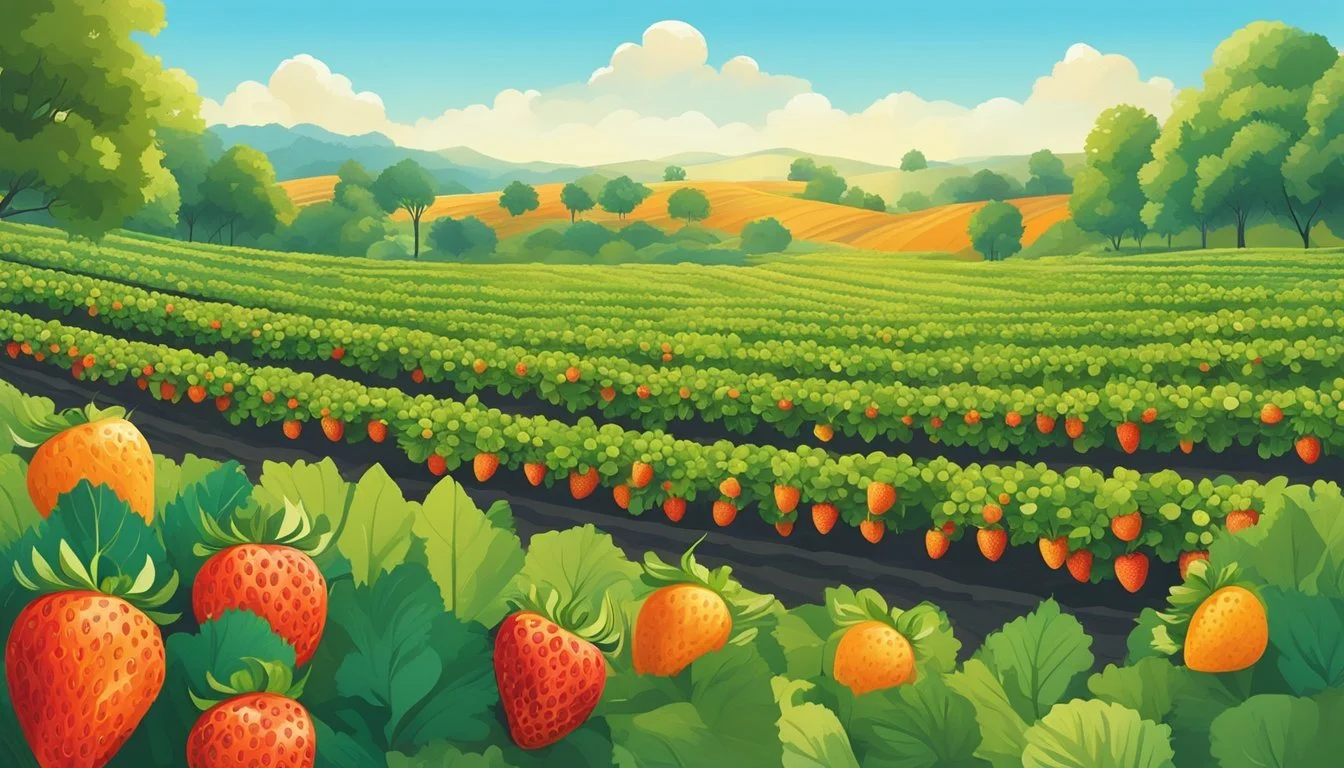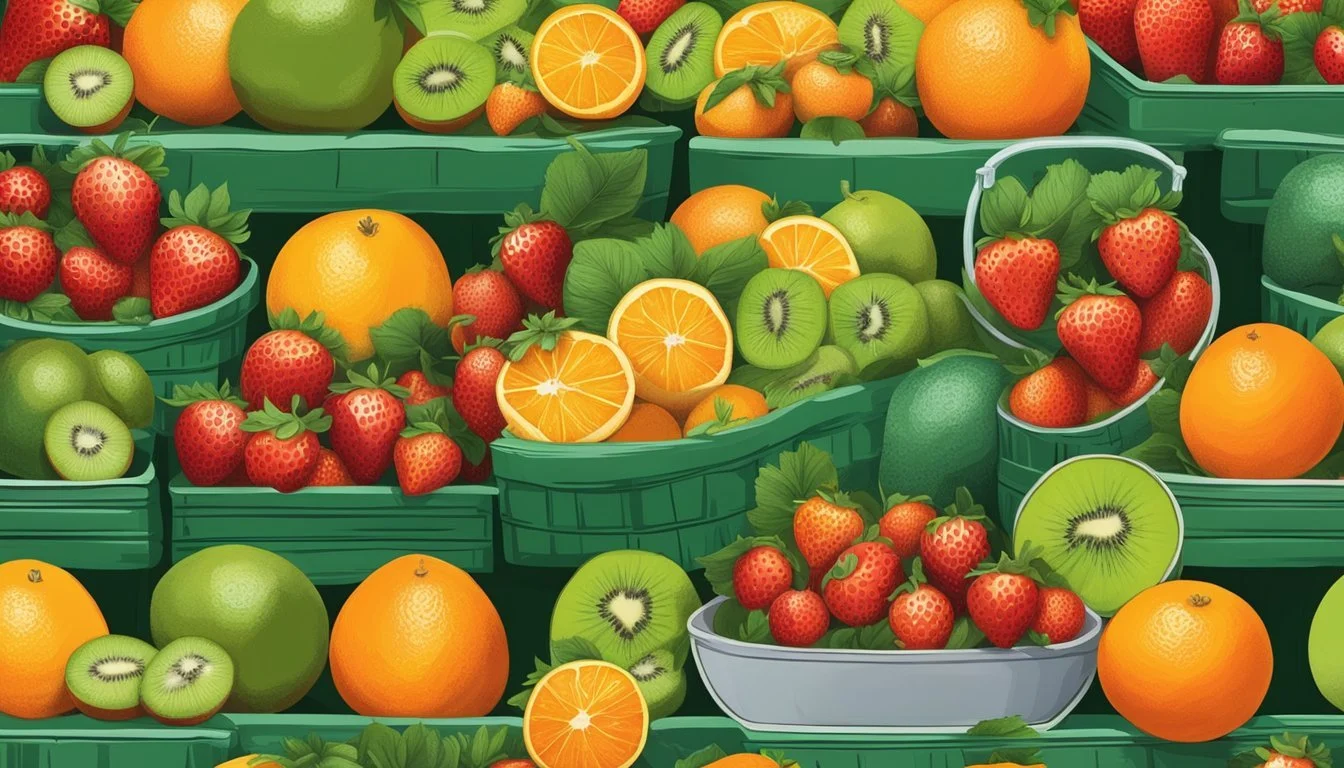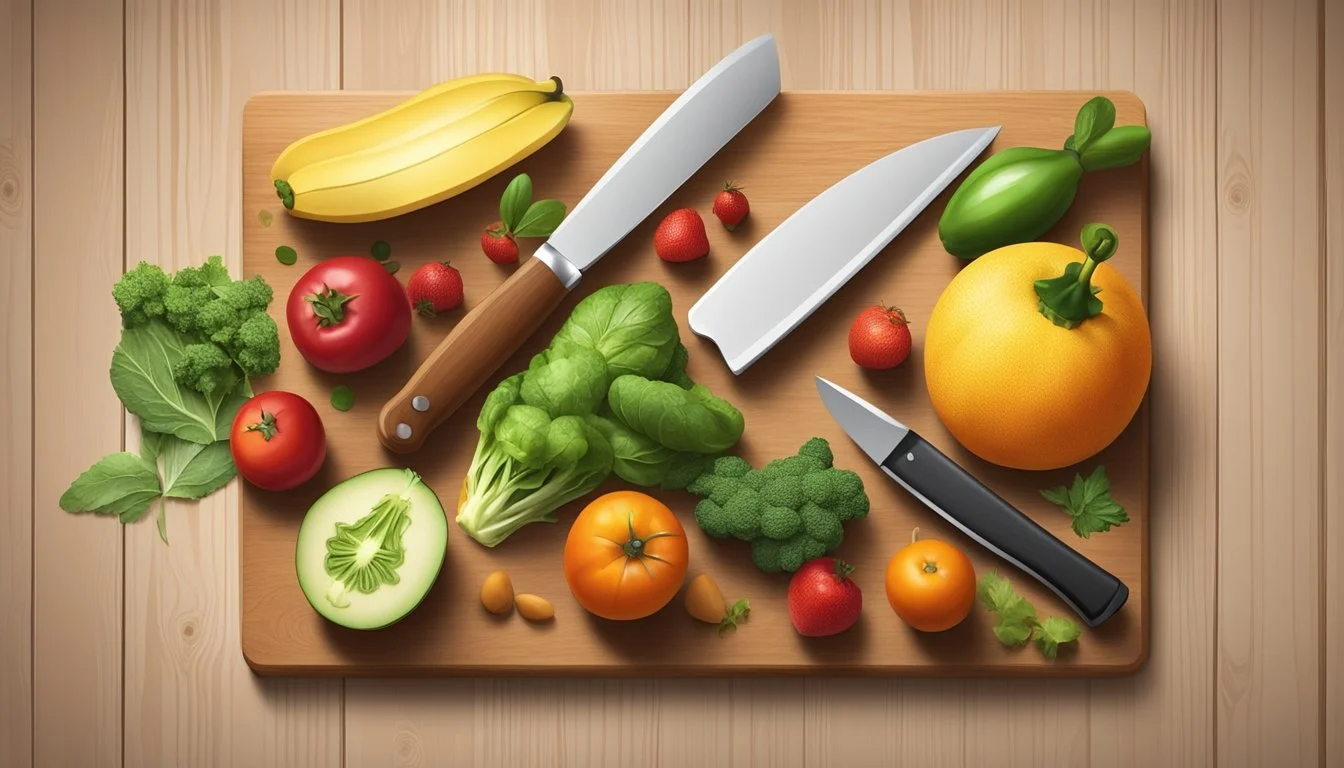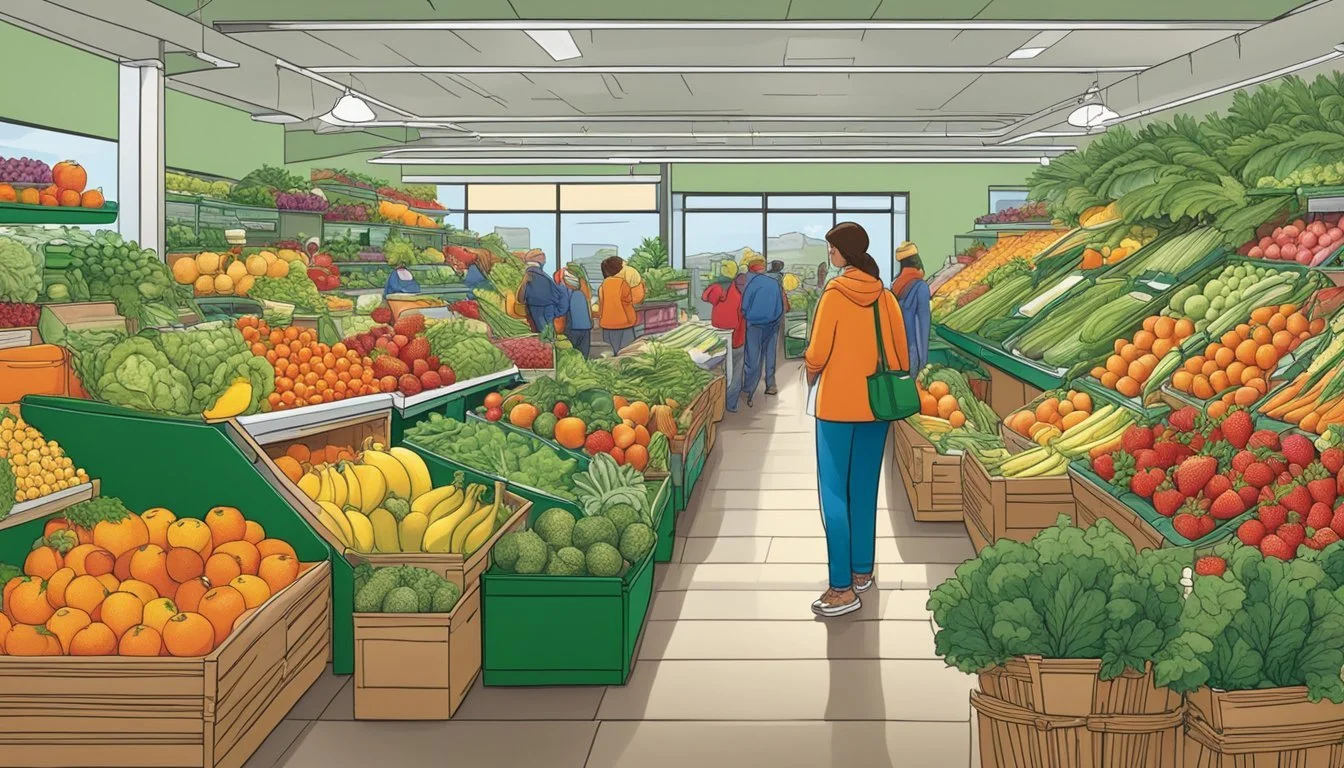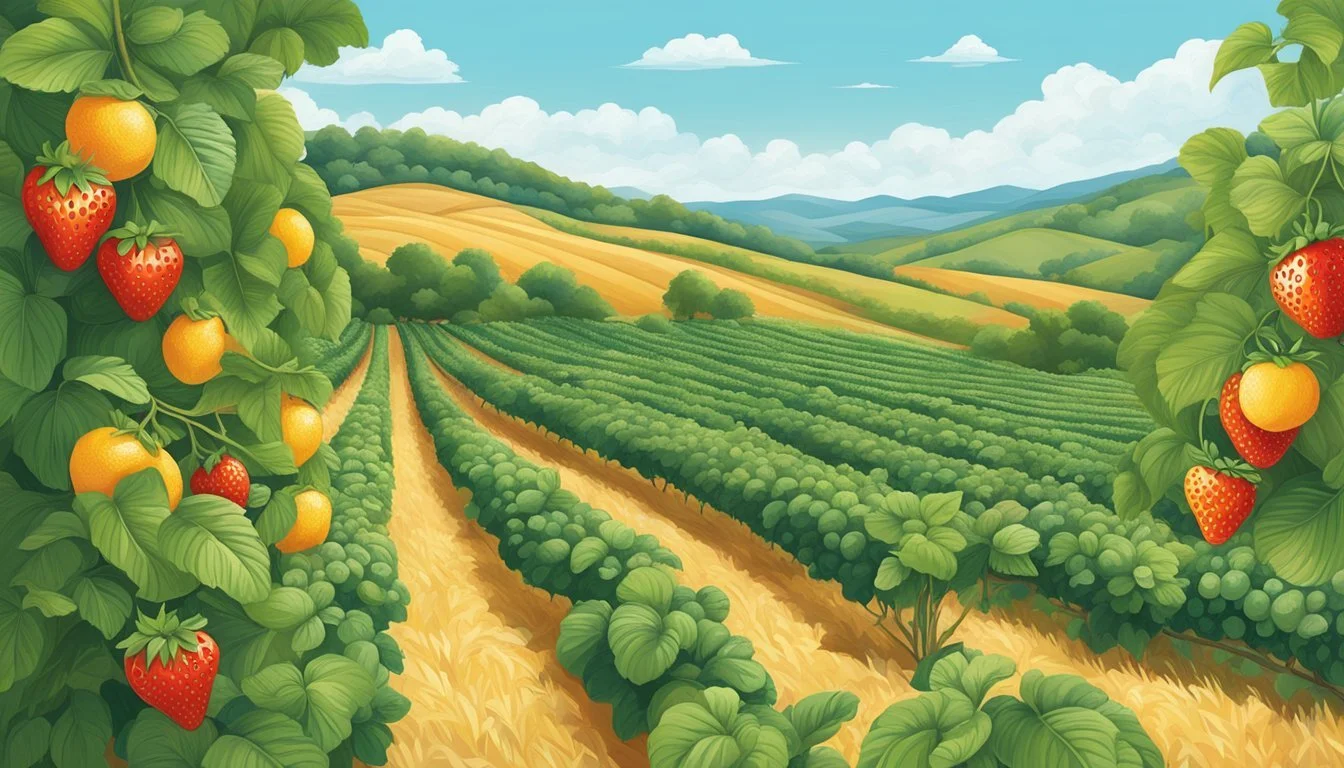California Seasonal Fruit & Vegetables in March
Your Fresh Produce Guide
This Article is Part of our California Seasonal Fruit & Veg Calendar
March in California heralds the arrival of spring and with it comes a vibrant selection of fruits and vegetables that not only promise fresh flavors but also bring a variety of nutritional benefits. The state's diverse climates and fertile soils make it an ideal environment for a wide array of produce, providing consumers with a bounty of choices that are at their peak during this month.
Fruit enthusiasts can savor the sweetness of strawberries that begin their season in the sunny fields of Ventura County, while vegetable connoisseurs can enjoy the crispness of asparagus (What wine goes well with asparagus?), freshly harvested during its prime time from March through June. Spinach (What wine goes well with spinach?), a leafy green that's as versatile as it is nutritious, remains available, having established itself as a year-round staple in the agriculture-rich state.
As residents and restaurateurs eagerly anticipate the freshest produce, California markets and grocery aisles become lined with the season's best. These seasonal offerings not only represent the state's agricultural prowess but also encourage a movement towards eating locally and seasonally, resulting in meals that are fresher, more flavorful, and often more sustainable.
Overview of California's Seasonal Produce
In California, March heralds the arrival of spring produce, offering a variety of fresh fruits and vegetables. Shoppers can find these items brimming at local farmers' markets and well-stocked in supermarkets.
Characteristics of Spring Produce
Spring in California ushers in a transition phase for crops. Earlier in the season, consumers can still find late winter produce such as oranges and kale, (What wine goes well with kale?) while later, they'll notice an influx of spring items like strawberries and artichokes (What wine goes well with artichokes?). In-Season fruits and vegetables that are harvested and consumed during their natural growing period tend to have enhanced flavor and nutritional profile. For instance, strawberries begin to appear in March and are notable for their vibrant red color and juiciness.
Benefits of Eating In-Season
Choosing in-season produce means enjoying the freshness and full flavor of fruits and vegetables. When produce is fresh, it has a higher nutritional value as the time from harvest to consumption is minimized, reducing nutrient loss. Furthermore, Spring produce often carries environmental benefits since it aligns with the natural crop calendar, which typically requires fewer artificial interventions. Eating in-season also supports the local economy, as purchasing seasonal items from a supermarket or farmers' market bolsters regional agriculture.
Seasonal Fruits in March
March in California is a vibrant time for fruit lovers, where the markets are brimming with an array of ripe, juicy options. Consumers can enjoy the last of winter's citrus and the beginning of spring's sweet berries.
Citrus Fruits
Grapefruit: This tangy fruit remains in season, giving a bittersweet burst of flavor. Its hefty size and juicy flesh are ideal for a refreshing morning start.
Oranges: Various types of oranges, such as the navel and cara cara, are both sweet and abundant. They offer a rich source of vitamin C and are perfect for eating fresh or juicing.
Berries
Strawberries: The early harvest of strawberries begins with berries that are especially sweet and tender. They can enhance the taste of desserts or be enjoyed on their own.
Other Seasonal Fruits
Avocado: While not typically sweet like other fruits, the avocado is a versatile ingredient that many consider a staple. It peaks in flavor and creaminess during this time.
Lemons: March sees the lemon at its ripest, ready to add a zesty flavor to dishes and drinks.
Seasonal Vegetables in March
March in California brings a vibrant variety of vegetables ripe for the picking. Here's what you can expect to find fresh in the market.
Leafy Greens
For those who love their salads and sautées, March is great for leafy greens. Shoppers can find an abundance of spinach, boasting its versatile use from fresh salads to cooked dishes. Kale and chard are also in full swing, providing hearty flavors and substantial nutritional benefits equally suited for raw or cooked preparations. Lettuce varieties are just as prolific, with many types from butter lettuce to romaine offering crispness to any dish.
Spinach: Rich in vitamins and perfect for a fresh salad or a hearty stew.
Kale: A robust green, great for chips or as a cooked side.
Chard: With colorful stems, adds both flavor and visual appeal to meals.
Lettuce: A staple for salads, available in multiple varieties.
Root Vegetables
Root veggies like beets, carrots, and turnips occupy a special place in March's selection. Beets offer a sweet, earthy flavor and can be roasted, boiled, or eaten raw. Meanwhile, carrots are at their sweetest, whether you munch them fresh or glaze them for a warm side dish. Turnips provide a slightly peppery taste and can be mashed or roasted for a comforting meal component.
Beets: Delicious roasted or pickled, providing earthy sweetness.
Carrots: Sweet and crunchy, versatile for both raw snacking and cooking.
Turnips: A bit peppery, perfect for mashing or roasting.
Other Seasonal Vegetables
March is not just about greens and root veggies; several other vegetables are in season. You can enjoy the flowering heads of broccoli (how long does broccoli last?)and cauliflower (how long does cauliflower last?), which can be steamed, roasted, or used in stir-fries. The compact heads of cabbage are also ready for harvest, ideal for slaws or ferments. Not to forget, mushrooms tend to peak during this time, with their umami flavor enriching any sauce, stir-fry, or as a meat substitute.
Broccoli: Great for a quick steam or roast, packed with vitamins.
Cauliflower: A low-carb favorite, easy to roast or turn into 'rice'.
Cabbage: Crunchy and versatile, from stir-fries to coleslaw.
Mushrooms: A flavorful addition to any dish, from pastas to soups.
March's vegetable bounty in California makes it an exciting time for consumers and chefs alike, thanks to the fresh, local produce available.
Preparation and Cooking Ideas
March brings a bounty of fresh produce to California, ripe for exploration in the kitchen. From crisp salads to warm comforting dishes, the versatility of this season's fruits and vegetables enables creativity for both novice and experienced cooks.
Salads and Raw Preparations
Salads are the perfect showcase for March's fresh produce. A simple dressing of olive oil, lemon juice, and a touch of garlic can elevate any combination of greens and sliced vegetables. For a refreshing touch, consider adding citrus segments or thin slices of fennel to your salads. Salsa made from freshly chopped tomatoes, onions, and cilantro adds a vibrant, raw element to any dish and is perfect for topping grilled fish or chicken.
Cooking Techniques for Vegetables
Vegetables like broccoli, Brussels sprouts, and carrots are abundant in March and lend themselves to a variety of cooking techniques. Roasting these vegetables with a light coating of olive oil and seasonings imparts a caramelized flavor that deepens their natural sweetness. To preserve color and texture, steaming vegetables is a quick and healthy option; finish with a pat of butter for richness. For pasta dishes, blanching vegetables before incorporating them ensures they remain bright and tender.
Roasting
Olive Oil: Enhances flavor.
Garlic: Adds aromatic depth.
Steaming
Preserve texture and color.
Finish with butter for added flavor.
Fruit-Inspired Recipes
Utilizing fruits in March's recipes can range from sweet to savory applications. A fruit salsa, combining diced strawberries or kiwis with jalapeno and lime juice, makes for a tantalizing addition to seafood or tacos. Incorporating fruit into desserts, such as a lemon zest-flavored olive oil cake, offers a fresh ending to any meal. Fruit can also provide a sweet contrast in a savory dish; for instance, a roast pork loin with a reduction of balsamic and fresh figs.
Savory Dishes: Add a fruit salsa for a fresh twist.
Desserts: Use olive oil and citrus to create light cakes.
Roast Pairings: Complement meats with fruit-based sauces.
Nutritional Information
In California during March, the available fruits and vegetables are packed with essential nutrients that contribute to a balanced diet and promote health.
Vitamins and Minerals
Citrus fruits, like blood oranges and grapefruits, shine as nutrient powerhouses during the March season. They are particularly noted for their high content of Vitamin C, a vital antioxidant known to support the immune system and skin health. Additionally, citrus fruits contain a range of other nutrients, such as potassium, folate, and fiber.
Kale and spinach are green leafy vegetables that are at their peak in March and are revered for their dense nutritional profile. They are a robust source of Vitamin K, which is necessary for blood clotting and bone health. These vegetables also provide substantial amounts of Vitamin A, supporting eye health, and they are good sources of calcium and iron.
Kale:
Vitamin A: 206% DV (per cup, cooked)
Vitamin K: 684% DV (per cup, cooked)
Spinach:
Vitamin A: 377% DV (per cup, cooked)
Vitamin K: 1110% DV (per cup, cooked)
Dietary Benefits
Consuming a diet that includes fresh, seasonal produce like that found in California during March can support overall health. The fiber found in vegetables such as broccoli, cabbage, carrots, cauliflower, and celery contributes to good digestive health and can aid in maintaining healthy blood sugar levels.
Fresh fruits and vegetables from the March harvest integrate seamlessly into a healthy diet and are associated with a lower risk of many chronic diseases. The various antioxidants and phytonutrients present in these foods are invaluable for their anti-inflammatory properties and their role in maintaining overall well-being.
Shopping Tips for Seasonal Produce
When shopping for seasonal produce in California in March, customers should prioritize freshness and plan for proper storage to maintain taste and nutrition. These tips ensure that the produce they invest in retains its quality from the supermarket to their table.
Selecting Fresh Produce
Shoppers should look for firmness in artichokes, indicative of peak ripeness, as these are a March staple. Citrus fruits like navel oranges should be heavy for their size, a sign they are juicy. When selecting leafy greens such as kale or chard, customers need to find vibrant, crisp leaves, avoiding any that are wilted or have yellow spots.
Artichokes: March to June
Citrus Fruits: Including navel oranges - Winter into early spring
Leafy Greens: Kale, Chard - Typically in season
For vegetables, the heavier they feel, the better—this often means they are loaded with moisture and are less likely to be dehydrated or limp.
Storing Fruits and Vegetables
Correct storage of fruits and vegetables is crucial. Artichokes should be kept in the refrigerator's crisper drawer where the humidity is higher. For citrus fruits, they can be stored either at room temperature or in the refrigerator, depending on how quickly they will be used.
Artichokes: Refrigerate in a plastic bag with some air holes.
Citrus: Room temperature for a few days, otherwise refrigerate.
Greens should be stored in a moisture-proof bag in the refrigerator to keep them crisp. They should also be washed only right before consumption to prevent premature spoilage.
Fruit and Vegetable Preservation
In California, March is a prime time for harvesting a variety of fresh produce. Proper preservation methods are vital for extending the shelf life of these foods and ensuring that their nutritional value is retained.
Canning and Pickling
Canning is a trusted method for preserving fresh fruits and vegetables. In this process, foods are placed in jars and heated to a temperature that eliminates microorganisms responsible for food spoilage. This method works well for a wide range of produce available in March, including asparagus and citrus fruits.
Steps for Canning Description 1. Prepare canning jars Clean, sterilize, and heat jars before filling them. 2. Fill with produce Pack the jars with fresh fruits or vegetables, leaving some headspace. 3. Seal and process Use a water bath or pressure canner to seal the jars and preserve the contents.
Pickling, on the other hand, involves immersing fruits and vegetables in a solution of vinegar, salt, and sometimes sugar. Asparagus and spring onions, which are in abundance during March, are excellent candidates for pickling.
Freezing Techniques
Freezing is a preservation technique that involves storing foods at temperatures below 0°F (-18°C). It is effective in maintaining the quality of fruits and vegetables by slowing down enzymatic degradation and microbial growth.
Instructions for Freezing Produce:
Blanching: Vegetables like asparagus should be briefly scalded in boiling water and then cooled in ice water to halt the cooking process before freezing.
Preparation: Fruits such as citrus segments can be peeled and sectioned, with excess air removed to prevent freezer burn.
Storage: Use air-tight, moisture-proof containers or freezer bags to prevent odor transfer and dehydration.
These techniques help extend the life of seasonal bounties, allowing consumers to enjoy the taste of March's fresh harvest well beyond its natural shelf life.
Exploring Regional Availability
California's diverse climate zones make it possible for a wide variety of fruits and vegetables to thrive across the state. In March, seasonal availability can vary significantly between the southern and northern regions.
Southern California Produce
In Southern California, the warm climate enables the cultivation of a broader selection of fruits and vegetables. March marks a period where one may find a rich bounty of produce:
Citrus Fruits: Oranges, lemons, and grapefruits remain in good supply, reflecting the tail end of their peak season.
Leafy Greens: Spinach and lettuces thrive, offering fresh and tender varieties perfect for salads.
Strawberries: The harvest begins in some areas, with the first sweet berries appearing in markets.
Avocados: The Hass variety, well-known for its creamy texture, is readily available during this month.
Northern California Varieties
The cooler temperatures of Northern California affect the types of produce that are available during the month of March:
Root Vegetables: Carrots, beets, and potatoes continue to be harvested, delivering earthy flavors. (What wine goes well with earthy flavors?)
Brassicas: Broccoli and cauliflower enjoy a prolonged harvest, thanks to the conducive cool weather.
Leafy Greens: Kale and chard are typically harvested, as they are resilient to the colder temperatures.
Apples: While not in peak season, many stored varieties from the previous fall harvest are still available and maintain their crispness and flavor.
The rich agricultural tapestry of California ensures a steady supply of fresh produce, with March showcasing a transition in seasonal offerings from winter heft to early spring freshness.
Impact on Local Economies
In California, the cultivation and sale of seasonal fruits and vegetables significantly boost local economies. As the largest agricultural producer in the United States, the state enjoys an influx of revenue from its agricultural sector. In March, the emphasis on seasonal produce means farmers are selling crops that are at peak ripeness, which often command higher prices due to both their quality and the reduced transportation costs.
Key Economic Drivers:
Revenue Generation: March sees a variety of crops such as strawberries and artichokes hitting the market, adding vitality to California's economy through direct sales and associated industries.
Support for Local Businesses: Purchasing seasonal produce supports local farmers and businesses, keeping profits within community circles.
It's critical to note the interconnectedness of the agricultural sector with other industries in California. Farmers markets and local vendors rely on the sale of seasonal produce for their livelihood. The trickle-down effect impacts:
Employment: There is a consistent demand for labor in agriculture, processing, distribution, and retail related to seasonal fruits and vegetables.
Tourism: Gastro-tourism attracts visitors to regions renowned for specific crops, contributing to the service sector's growth.
Seasonal Produce Impact on Economy:
Month Notable Crops Economic Benefit March Strawberries, Citrus High demand, Increased Revenue
In summary, the seasonal produce of March is more than a culinary delight; it serves as a cornerstone for economic stability and growth in Californian localities.
Seasonality Charts and Resources
March in California ushers in a bountiful period for a variety of fruits and vegetables. One can access many charts and resources that meticulously detail the seasonality of these produce items.
Seasonality Charts are integral for both consumers and businesses to identify what is freshly available. These charts offer a month-by-month breakdown, showcasing availability at a glance. They generally list a vast array of produce, denoting the peak seasons, availability, and gaps in the harvest cycle.
For fruits in March, consumers can usually expect to find a selection of:
Citrus fruits like oranges, mandarins, and lemons
Strawberries starting their season
Avocados continuing their availability
The vegetable selection often features:
Asparagus beginning its short but vibrant season
Artichokes reaching their peak
A variety of leafy greens such as spinach and lettuce
Many resources, such as the California Department of Agriculture, also provide comprehensive guides and information, aiding in menu planning or nutrition education. Farmers' markets act as a live catalog for seasonal produce, often supported by signage indicating the locally-grown produce stocked for the month.
When consulting these charts and resources, it's critical to understand that the specific availability can vary due to regional growing conditions and weather patterns. Thus, consumers are encouraged to utilize these tools as guides rather than definitive rules, fostering a flexible approach to eating seasonally and supporting local agriculture.
Conclusion
March marks a vibrant period for fresh, seasonal produce in California. Shoppers have the opportunity to enjoy an array of fruits and vegetables that are at their peak of freshness. The state's diverse climate zones contribute to a rich agricultural bounty, ensuring that Californians and visitors alike can savor a variety of high-quality produce.
Fruits in Season:
Strawberries: These begin their peak season, which lasts until July.
Citrus fruits: Including oranges and lemons, continue to be plentiful.
Vegetables in Season:
Leafy greens: Kale and chard offer rich nutrition and vibrant flavors.
Artichokes: These reach their best quality and are widely available.
Asparagus: Another spring favorite, known for its tender shoots.
For those seeking the freshest produce, farmers' markets are ideal destinations, as they directly provide the fruits of local harvests. When selecting produce, signs of optimal freshness include vibrant color, firm texture, and a natural, healthy appearance.
Consumers are encouraged to partake in the season's offerings, as they are not only at their best in terms of flavor and nutritional value but also support sustainable, local agriculture. By opting for seasonal produce, individuals make a choice that benefits both their health and the environment.
The spirit of the season is best embraced through the enjoyment of these fresh products, which reflect the agricultural wealth of California.


